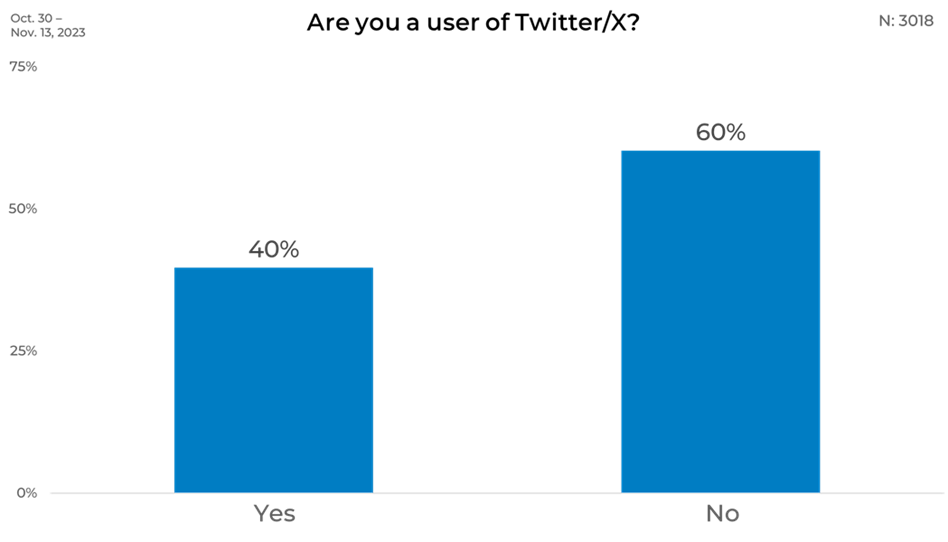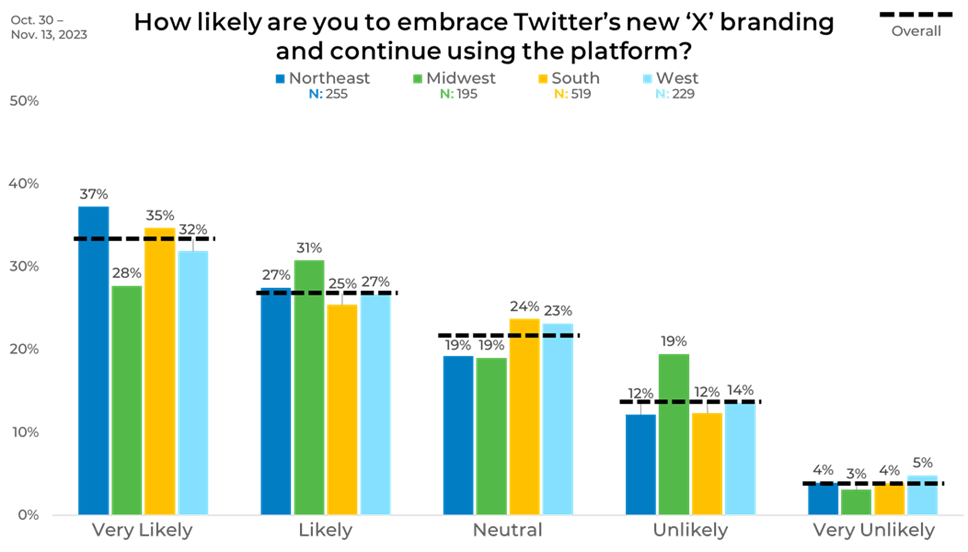
Election 2024: Who Are You Voting For?
January 22, 2024
New Year, New Intellicast
January 25, 2024It has been nearly nine months since Twitter rebranded to X. Along the way, there has also been a lot of news about the platform – some good, some not so much. With the rebranding, we wanted to understand the usage of X better and if people are embracing the new branding.
We started with a fundamental question to understand the landscape: “Are you a user of Twitter/X?” The split in responses was intriguing – 40% of our respondents are current users of Twitter/X, while a significant 60% are not. This set the stage for a deeper dive into the current users’ perceptions, especially regarding the platform’s recent rebranding. Let’s dive into the perceptions of the rebrand.

Overall, 34% of users are excited and ready to embrace the rebrand, indicating a seamless transition for them. Another 27% are likely to continue using Twitter despite a sense of nostalgia for the old branding. In the middle, 22% remain neutral, suggesting that the change in branding isn’t a significant concern for their continued usage. However, not everyone likes the change. Approximately 14% are hesitant, preferring the classic Twitter, and 4% are so opposed that they might even consider leaving the platform.

Gender
Analyzing the responses to Twitter’s ‘X’ rebranding by gender reveals some intriguing differences. Among men, 39% are likely to embrace the new branding, compared to 28% of women. In contrast, women are more resistant; 17% prefer the classic Twitter and are unlikely to embrace the new look, higher than the 11% of men who feel the same. This points to a stronger attachment to the classic branding among female users.
The extremes of the spectrum further highlight these differences. Only 2% of men are unlikely to continue using Twitter due to the rebranding, but this sentiment is more pronounced among women, with 5% considering leaving the platform. Despite these differences, both genders show a significant portion feeling neutral (21% of men and 22% of women) or likely to continue using Twitter despite missing the old branding (26% of men and 28% of women), indicating a blend of adaptability and nostalgia across the board.

Age
When looking at the rebrand perceptions by age, we found that the younger cohort (18-24) and the oldest (65+) accepted the rebrand at an equal rate of 26%. However, the group aged 35-44 leads the charge in adaptability, with a notable 43% ready to accept the new branding.
On the flip side, the youngest adults (18-24) also show the highest level of resistance, with 18% unlikely to welcome the change and 6% unlikely to stay with Twitter, hinting at a stronger attachment to the platform’s traditional. Interestingly, those over 65 are the most neutral (33%), suggesting that the platform’s functionality may trump branding changes for them.

Income
When looking at the results by income, those in the highest income bracket (earning $100,000+) lead the pack with 45% “Very likely” to embrace the rebrand. The enthusiasm for change appears to taper off slightly with lower income brackets, with 31% of users under $20,000 also eager to accept the rebranding, matching their higher likelihood of missing the old branding.
Regarding resistance to Twitter’s new ‘X’ branding, middle-income earners ($40,000 – $59,999) display a more varied reaction, with 16% feeling unlikely to embrace the change — this is a bit higher compared to other income groups. At both ends of the income spectrum, those earning under $20,000 and above $100,000 show less resistance to the change. Across all incomes, the proportion of users considering leaving Twitter due to the new branding remains slight but notable.

Political Affiliation
The sentiments toward Twitter’s ‘X’ rebranding have a definite political lean. Republicans appear to be the most receptive to the rebranding, with 42% indicating they’re very likely to embrace the change quickly, a figure that stands above Democrats (37%), Independents (23%), and those of other political leanings (24%).
Interestingly, Independents and those of other affiliations lead in neutrality, with 27% and 32% not minding either branding.

Region
The rebranding of Twitter has varied reactions across different regions of the United States. There’s a relatively high openness to change in the Northeast, with 37% of users very likely to embrace the X branding. The Midwest shows a balanced perspective, with the highest percentage, 31%, likely to miss the classic Twitter yet still willing to continue using the platform. In the South, users are more evenly distributed across the spectrum of opinions, with a notable 24% feeling neutral about the branding. The West, known for its tech-savvy population, has a moderate 32% very likely to embrace the change, but also the highest percentage, at 5%, very unlikely to continue using the platform.

Panel
The panels surveyed about Twitter’s rebranding to ‘X’ display distinct responses that underscore the diversity of user sentiment. Panel E is markedly the most receptive, with 47% “Very likely” to embrace the change, the highest across all groups. In stark contrast, Panel A shows the least enthusiasm for the rebranding, with only 14% as likely to embrace change readily — the most significant difference observed between any panels.
Panel B’s notable 41% who are “Likely” to continue using Twitter despite missing the old branding indicates a sentimental yet adaptable group. In comparison, Panel D’s 24% “Unlikely” to welcome the change suggests a strong affinity for the traditional experience of the platform. This highlights the differences in results you can get based on the panel or panels you use for your research.

We then asked what aspect of Twitter’s rebrand to X most appealed to respondents. Overall, the potential for platform improvements and new features leads the way, with 15% of respondents finding this to be the most appealing element of the rebranding efforts. This is followed by 13% who are drawn to the new logo design.
However, it’s notable that a majority of the respondents, 57%, aren’t captivated by any facet of the rebranding — an indicator that for many users, the essence of Twitter lies in its current form and function rather than in a refreshed identity. Only a tiny fraction sees the appeal associated with a fresh brand identity (7%) or finds the general excitement of change and reinvention (5%) enticing. This overarching preference for the status quo or skepticism towards the rebranding underscores the challenges Twitter’ X’ may face in its pursuit to reinvigorate the platform’s appeal.

Want to understand how panels can impact your data? Download The Sample Landscape today!




